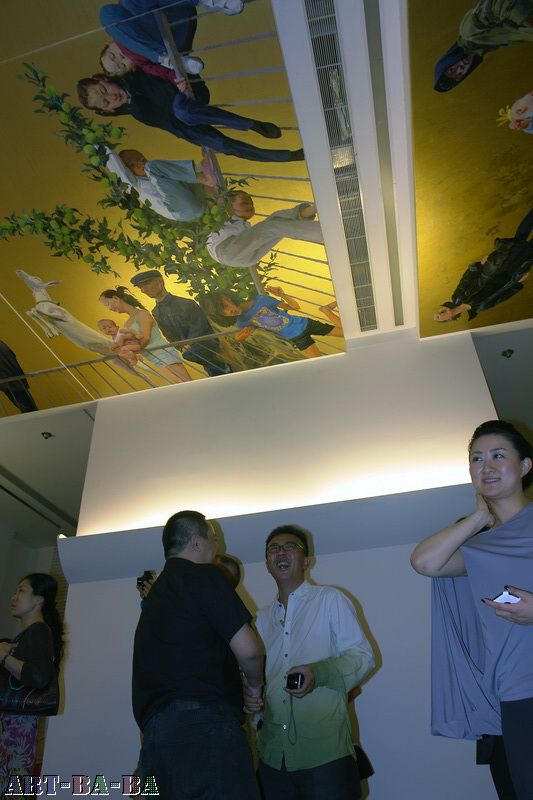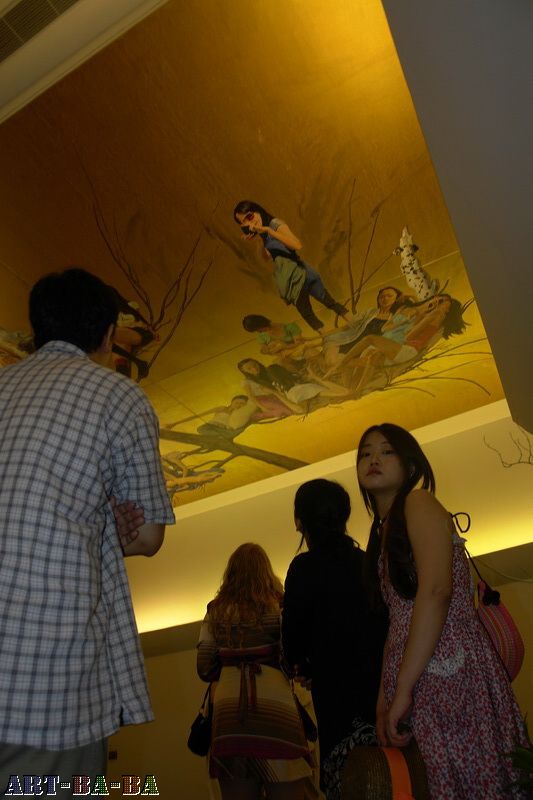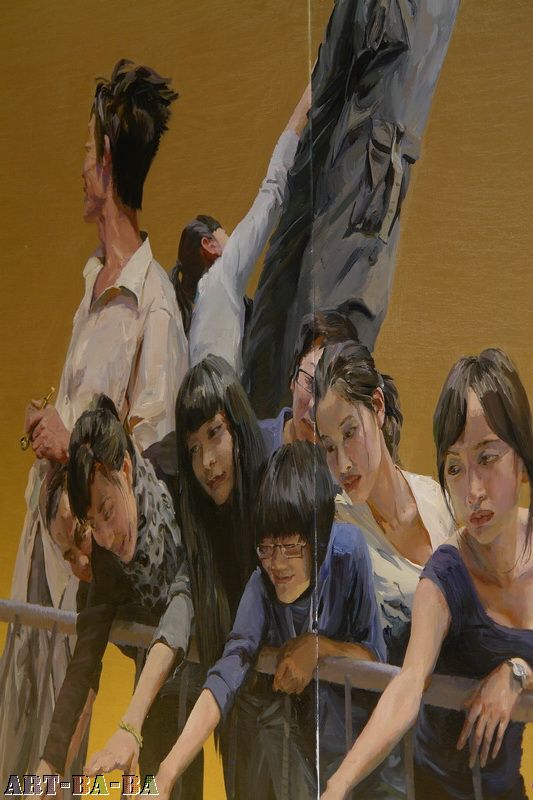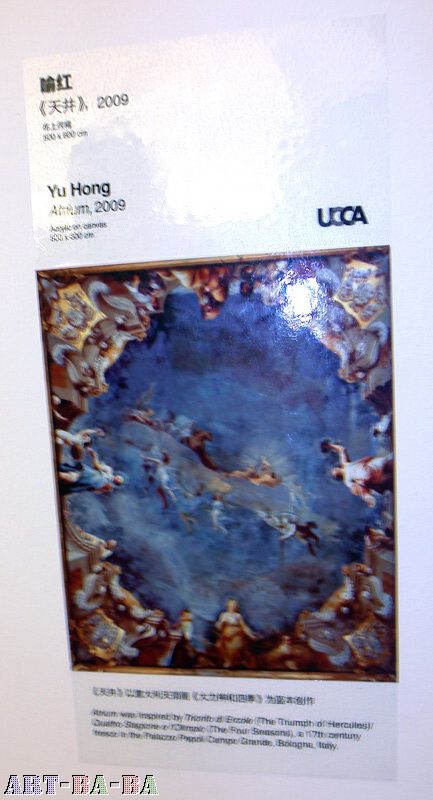[View] Yu Hong - Golden Sky - UCCA

YU HONG——GOLDEN SKY
DATE: July 17, 2010 - September 15, 2010
VENUE: UCCA Middle Room
Curators: Jérôme Sans, UCCA Director
Project Coordinator:Paula Tsai
Text source: UCCA website
In her new series Golden Sky , acclaimed painter Yu Hong reanimates history by combining classical and religious composition with scenes from modern, secular life. Inspired by the Buddhist cave paintings of Dunhuang and Kizil, classical western works of art and her own extensive reading and scholarship, the artist populates her large canvases with vivid, life-sized figures that are as familiar to us as we are to them: men, women and children going about their daily lives against the backdrop of a golden sky, citizens of a gilded and uncertain age.
In art as in life, a slight shift in perspective can lead to a greatly altered perception. Displaying Yu Hong's paintings on the ceiling reinvigorates the relationship between viewer and viewed, subject and object, artist and audience. As we gaze up at the people in Yu Hong's paintings and they gaze back at us, one thing seems clear: all of us are looking at a present that will someday be history.
- Jérôme Sans, UCCA Director
Yu Hong: Reconstructing and Reinterpreting the Classical
When a work of art becomes a classic, or is transformed from a classic into a symbol, its meaning becomes fixed. Later, as the work is reconstructed and reinterpreted over time, it acquires new layers of complexity and takes on a broader moral and intellectual significance. The process by which this happens is not unlike a mathematical equation: no matter how complex the formula, under a given mathematical framework, substituting certain values for X will yield different results for Y. In the case of Yu Hong, instead of presenting us with her own personal preferences and tastes, the artist offers us a whole set of X variables – some true, some false – reflecting different kinds of values that society imposes on the individual. Substituting these values into the historical equation yields a range of Y values we can use to critically examine our value systems, ideas and attitudes about tradition and modernity, evolution and reincarnation, individual identity and collective consciousness and a range of other topics.
The works in this exhibition—Atrium, Questions for Heaven, Natural Selection and Sky Curtain—represent a continuation of the artistic path Yu Hong set out on several years ago. Drawing on extensive reading and careful scholarship, she incorporates elements of classical composition to reanimate ancient Chinese and western culture from a contemporary standpoint and express a modern artistic sensibility. By stripping classical works of their religious, mythological, historical and literary associations and replacing them with subjects and subject matter from the present day, Yu Hong translates the classical language of painting into a modern vernacular. By placing modern symbols in a traditional or classical framework, the artist is not simply creating meaningless permutations of ready-made symbols, but taking symbols out of context and sidestepping their origin to reinterpret and reconstruct them. The fact that Yu Hong does this so successfully is a testament to her profound scholarship and knowledge of art history, as well as her unique way of seeing the world and thinking about culture.
Incorporating modern day concepts and critical thinking into classical works of art does not rob classical motifs of their original power or cultural significance; rather, it reanimates them in a non-classical, non-iconic present, and makes them part of a larger socio-historical dialogue about the helplessness, restlessness, apathy, anomie, alienation and other ailments that plague our modernity.
The decision to display Yu Hong’s canvases on the ceiling allows us to engage with her work on a deeper level. It is akin to a religious experience: as we gaze up at her paintings, we marvel not just at the beauty and majesty of their composition, but at the epiphanies they inspire.
- Zheng Yan, Head of Art Department
ARTIST STATEMENT
For the last several years, I've been very focused on classical Chinese and western culture. Bycombining research into traditional culture with a re-examination of contemporary society, I hope to create works of art that transcend cultural barriers and capture the essence of something universal.
Atrium was inspired by Trionfo di Ercole (Triumph of Hercules) from the Quattro Stagione del'Olimpio (Four Seasons of Olympia) fresco at the Palazzo Pepoli Campo Grande in Bologna, Italy, but the subjects are people I've taken casual snapshots of. They're all going about their lives, playing and talking and reaching out for things unseen. It's just like in real life: none of us can see everything, or escape our own blind spots.
Questions for Heaven takes its composition from a Buddhist cave painting from Dunhuang's Mogao Grottoes, and its title from a two-thousand-year old poem that poses 172 questions about the universe. It expresses the uncertainty people feel in our fast-paced society, the doubts and unanswered questions we have about the world, life, ethics, morality, and economic and social development.
Natural Selection is modeled on Ridiculous Folly , a copperplate etching by Francisco Goya. It explores the relationship between human beings and the civilization we create. If through our own greed and folly, we lose the civilization we've made, we'll end up right back where we started and our lives will be duller than ever.
Sky Curtain relates to a cave painting that once adorned the grottoes in Kizil, Xinjiang Province. To that composi t ion, I added elements of contemporary news photos to illustrate the cycle of humanity – birth and death, ignorance and wisdom, loss and gain – and force the viewer to confront the unavoidable realities of life. These four paintings will be displayed on the ceiling of the Middle Room at UCCA. I hope the effect will be like classical ceiling frescoes: viewers will raise their heads to look up at them, and the subjects in the paintings will gaze back down.





